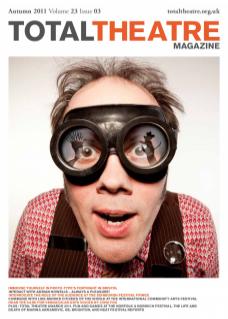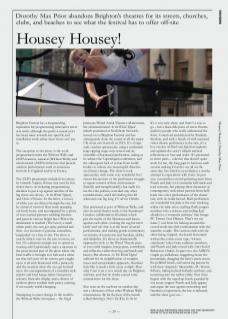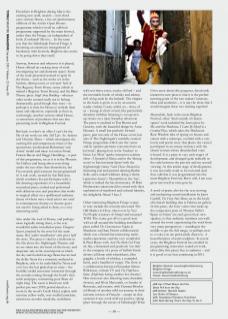Brighton Festival has a long-standing reputation for programming innovative street arts work, although the push in recent years has been more towards site-specific and installation work rather than ‘street arts’ per se.
The exception to the above is the work programmed under the Without Walls and ZEPA banners, national (Without Walls) and international (ZEPA) initiatives that present outdoor performance work at numerous festivals in England and/or in France.
The ZEPA programme included two pieces by Generik Vapeur, Bivouac (not seen by this writer due to an irritating programming decision to put it up against another of the big street arts shows, As the World Tipped), and Droles d’Oiseaux. In the latter, a convoy of white cars are driven through the city, led by a kind of carnival float truck pumping out beefy beats, and accompanied by a posse of over-excited painters wielding brushes and paint in various bright hues. When the destination is reached (The Level, a small urban park), the cars get spray-painted and then, in a moment of genuine surrealism, ‘suspended’ on a line to dry. The show is exactly what it says on the can: no more, no less. It’s a pleasant enough way to spend an evening and I particularly enjoy a moment in the processional part of the piece where the local traffic is brought to a halt and a white car that isn’t part of the convoy gets caught up in it all and threatened with a paint job; and the moment when the cars get hoisted up to the accompaniment of a mascletà-style (smoke and loud bangs rather than pretty colours) fireworks display and a shower of rainbow glitter confetti feels pretty exciting, if not exactly world-changing.
Attempting to enact change in the world is the Without Walls showpiece – the Nigel Jamieson/Wired Aerial Theatre collaboration, the aforementioned As the World Tipped (which premiered at Norfolk & Norwich, moved on to Brighton Festival and has subsequently done the round of all the major UK street arts festivals in 2011). It’s a largescale outdoor spectacular, using a trademark large tipping stage-cum-screen and an ensemble of harnessed performers, taking as its subject the Copenhagen conference, and the subsequent lack of action from world leaders to initiate any meaningful directive on climate change. The show is truly spectacular, with some very wonderful live/ screen interactions as the performers struggle to regain control of their environment (literally and metaphorically), but sadly for me the trite politics overruled any other considerations, and I left feeling that I’d witnessed one big long TV ad for Oxfam.
Also presented as part of Without Walls, and also an aerial theatre work, is the Scarabeus/ Candoco collaboration Heartland, which pits the myths of the Minotaur and Icarus against each other, evoking the tug between ‘earth’ and ‘air’ that is at the heart of aerial performance, and making gentle commentary on notions of restriction and freedom, ability and disability. It’s about as diametrically opposed in style to the Wired Theatre piece as you could imagine, being quiet, considered, and reflective rather than big and brash and breezy. But whereas As The World Tipped suffered for its simplification of complex issues and sensationalist approach, Heartland feels like it needs a little more oomph. That said, I saw it on a very windy day on Brighton seafront, and that no doubt caused some constrictions for the show.
Also seen on the seafront on another day was a showcase of four other Without Walls commissions. By far the best of the bunch is Red Herring’s That’s The Way To Do It! It’s a very new show, and there’s a way to go – but a bona fide piece of street theatre, made by people who really understand the form. Conceived and directed by Paschale Straiton, and with a bunch of well-seasoned street theatre performers in the mix, it’s a live version of Punch and Judy that explores and updates the story’s inbuilt satirical reflections on ‘law and order’. It’s presented in three parts – a device that doesn’t quite work for me, the long gaps in between each section making it hard to see all on the same day, but which is nevertheless a worthy attempt to experiment with form. In part one, a roustabout crowd-gathering intro from Punch and Judy (in Commedia half-mask and trad costume, but playing their characters as contemporary sink-estate parents-from-hell) leads into a live performance of the classic tale, with no holds barred. Both performers are wonderful but Judy is the star: smoking whilst the baby cries; stuffing fluffy puppet monkeys into a mincer; and ending legsakimbo in a ‘romantic embrace’ that brings PC Timms (‘not Dimms. That’s not my name.’) out from his lurking-around-thecrowd mode into full confrontation with the anarchic couple. This section ends with the show being stopped, the booth festooned with police crime-scene tape, ‘witness statements’ taken from audience members, and Punch and Judy issued with Anti-Social Behaviour Orders. In part two, the ASBO’d couple go walkabout: staggering down the promenade, dragging the baby’s pram across the pebbled beach, and accosting passers-by with their ‘slapstick’. Meanwhile, PC Timms follows, hiding behind bollards and bins, and muttering into his walkie-talkie. Part three begins with the taped-up booth guarded by our trusty copper. Punch and Judy appear and argue the case against censorship and freedom of expression, the law is defeated, and the show goes on…
Elsewhere in Brighton during May is the exciting new (well, newish – in its third year) venture House, a live art/performance offshoot of the Artists Open Houses programme which is itself an odd-bod programme supported by the main festival, rather than the Fringe, yet independent of both. (Confused? Me too… In the same way that the Edinburgh Festival Fringe is becoming an enormous smorgasbord of breakaway mini festivals, Brighton also seems to be going down that road!)
Anyway, however and wherever it is placed, House offered an exciting array of work investigating ‘art and domestic space’. Some of the work presented seemed to aptly fit the frame – such as the works set in the kitchen, dining room, or servants’ hall of The Regency Town House venue (which is indeed a Regency Town House); and the Blast Theory piece Single Story Building – whereas other works seemed really not to belong thematically, good though they were – so perhaps it is time for House to rethink their name and objectives, especially as there is, confusingly, another venture called House, a consortium of producers that was also presenting work in Brighton Festival.
But back to what’s on offer: I can’t for the life of me work out why Still Life: An Audience with Henrietta Moraes – which investigates the exciting life and tempestuous times of the eponymous ‘professional Bohemian’ and artists’ model and muse to Lucian Freud, Francis Bacon and Maggi Hambling – is part of this programme, set as it is in the Phoenix Art Gallery and being about everything under the sun other than domesticity, but I’m certainly glad someone has programmed it! A solo work, created by Sue McLaine, which combines live performance with a life-drawing experience: it’s a beautifully researched piece, crafted and performed with delicious care and precision that works to magical effect on a spellbound audience (many of whom were visual artists not used to contemporary theatre; or theatre-goers not used to being asked to draw, so a very interesting mix!).
Also under the roof of House, and perhaps more logically sitting there, is the very wonderful audio-installation piece Hangover Square, inspired by the novel of the same name. But ‘audio-installation’ only gives half the story. The piece is sited in a bedroom in the flat above the Nightingale Theatre, and we are taken into the heart of this boozy and desperate tale at the crucial point at which the shy and foolish George Bone has invited the fickle Netta for a romantic weekend in Brighton, only to be cuckolded by Netta and a toy boy she has picked up en route – the horribly sordid encounter witnessed through the sounds coming through the hotel’s thin walls and pipes, tormenting poor Bone all night long. The room is kitted out with perfect pre-war (1939) period detail as a room in the novel’s Castle Hotel, replete with nicotine yellow walls, over-stuffed armchair, monstrous wooden wardrobe, washbasin with wet-shave razor, creaky old bed – and the inevitable bottle of whisky and ashtray full of fag-ends by the bedside. The chapter in the book is given to us by an unseen reader (Ashley Cook), whilst we – three of us – lounge in chair or bed, like particularly decadent children listening to too-grownup stories on a rainy Saturday afternoon. The piece is credited to Tim Brown and Cinecity, with the beautiful design by Anna Deamer. A small but perfectly formed piece, part not only of the House event, but also of The Nightingale’s carefully curated Fringe programme which saw the venue and its upstairs premises converted into an ‘art hotel’, playing host in the ‘kitchen’ to Entre Les Mots’ quirky interactive teatime show A Spoonful of Silence; and in the ‘dining room’ to Inconvenient Spoof with the frighteningly funny Naïve Dance Masterclass (featuring real and pretend dancing Barbie dolls, and a naked wildman doing a fleshy ‘expressive dance’). Meanwhile in the ‘bar’, which is indeed the bar downstairs, 30 Bird Productions entertained the crowd with their exploration of manhood and cultural identity, the delightful Poland 3 Iran 2.
Other interesting Brighton Fringe venues to note include the recently-renovated The Old Market in Hove, taken over by Yes/ No People (creators of Stomp!) and renamed TOM. The venue got off to a good start with an all-around-the-building installation piece called The Consciousness Engine (a Shardcore and Sam Hewitt collaboration) which was a flawed but interesting multimedia experience; and the very wonderful Il Pixel Rosso with And The Birds Fell From the Sky, a demented and psychotic ‘car ride’ in the company of a posse of hellish Faruk clowns (all done with wheelchairs, film goggles, a bottle of whiskey, a crumpled letter, and a handful of twigs). The show is a collaboration between filmmaker Simon Wilkinson, of Junk TV and The FlopHouse fame (FlopHouse being another live theatre/ film crossover also featuring nasty decadent clowns), and Silvia Mercuriali, co-founder of Rotozaza, and creator, with Gemma Brockis (of Shunt) of another wild car journey in their extreme version of Pinocchio – except on that occasion it was a real wild car journey, taking place through the streets of Edinburgh! What I love most about this gorgeous, ferociously immersive new piece is that it is the perfect meeting point of the two makers’ interests, ideas and aesthetics – it is just the show that I would imagine these two making together!
Meanwhile, back in the main Brighton Festival, other ‘sited outside of theatre spaces’ work included the latest piece by Me and the Machine, I Came By Myself to a Crowded Place, which takes the Hitchcock Rear Window idea of spying on houses and streets with a telescope, overlaid with a very lovely and poetic story that places the viewer/ participant in an uneasy intimacy with the absent woman whose disembodied voice is heard. It is a piece in very early stages of development, and changed quite radically in the time between the preview and my second viewing. At this tender stage of development, it was not really ready to be reviewed (and thus odd that it was programmed into the main Brighton Festival). But it will, I am sure, grow into itself as time goes by.
A word of praise also for the very moving and enchanting sound installation by Janet Cardiff, The Forty Part Motet, set in the lovely old church building that is Fabrica art gallery. In this piece, the forty voices that make up the component parts of Thomas Tallis’s ‘Spem in Alium’ are each given their own speaker, so that audience members can walk around the room experiencing the work from very many perspectives – standing in the middle to get the full range, or perhaps next to a voice you are particularly drawn to. A beautiful piece of aural sculpture. In recent years, the Brighton Festival has excelled in programming innovative sound-art work, often (like this piece) free to audience – and it is good to see that continuing in 2011.
Brighton Festival: www.brightonfestival.org
Brighton Fringe: www.brightonfestivalfringe.co.uk
House: www.housefestival.org


